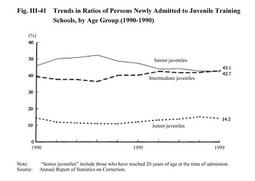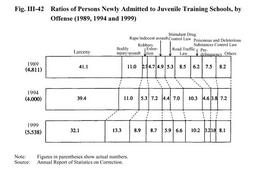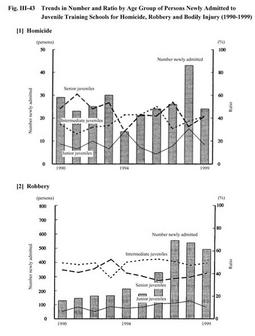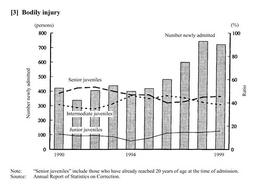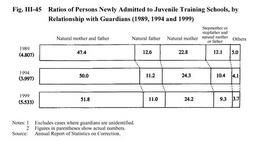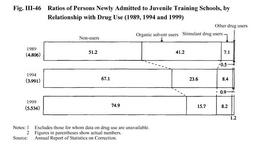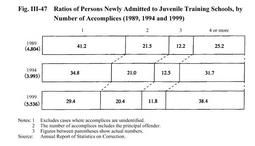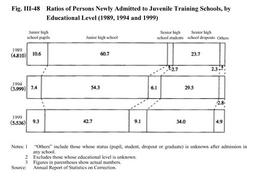| Previous Next Index Image Index Year Selection | |
|
|
3 Characteristics of Newly Admitted Juveniles (1)Age at time of admission
Fig. III-41 shows trends in the ratios of juveniles newly admitted since 1990,by age group. Although senior juveniles traditionally had the largest share, the ratio of intermediate juveniles has been rising in recent years and slightly exceeded that of senior juveniles in1999. As regards age at the time of admission by gender,17-year-olds had the largest share in the number of males newly admitted in1999(24.8%), followed by18-year-olds(22.9%),19years olds(20.5%)and16-year-olds(18.3%). On the other hand,16-year-olds were most prevalent among females(23.0%), followed by17-year-olds(20.6%),18-year-olds(17.6%)and19-year-olds(16.8%)(see Appendix III-14 ). Fig. III-41 Trends in Ratios of Persons Newly Admitted to Juvenile Training Schools, by Age Group(1990-1990) (2) Foreign juveniles Of those newly admitted to juvenile training schools in1999,23juveniles(all males)were placed in the living guidance course(G2)as foreign nationals who need treatment programs different from Japanese nationals(hereinafter referred to as"foreign juveniles"). By nationality, Brazilians(19)had the largest share. By age,19-year-olds accounted for the largest share(6), followed by17-and18-year-olds(5each)and15-year-olds(4). By offense, larceny was most prevalent(15), followed by robbery(6), and bodily injury and Stimulant Drug Control Law violations(1each)(source:Annual Report of Statistics on Correction). Traditionally, foreign juveniles used to be admitted to Kurihama Juvenile Training School(males)or Haruna Female Juvenile Training School. Since December1999,however, they have been admitted to juvenile training schools of the regional correction headquarters within the jurisdiction of the family courts that adjudicated the relevant cases, with the exception of those who require special consideration due to difficulty in understanding guidance in Japanese, for example. (Females are admitted to one of the three juvenile training schools designated as broad region schools. )In these schools, guidance for learning Japanese is provided according to the needs of individual foreign juveniles, along with guidance on problematic behavior and future prospects including repatriation, among others. (3) Categories of offense The ratios of juveniles newly admitted in1989,1994and1999by offense are shown in Fig. III-42. The ratio of larceny was largest in each of the three years, but has been on a downward trend. The ratios of bodily injury/assault, robbery and extortion are on the rise. Fig. III-42 Ratios of Persons Newly Admitted to Juvenile Training Schools, by Offense(1989,1994and1999) By gender, larceny accounts for the majority of the males newly admitted in1999(33.7%), followed by bodily injury/assault(13.4%)and Road Traffic Law violations(11.1%). Stimulant Drug Control Law violations were most prevalent among females(30.6%), followed by larceny(15.6%)and pre-delinquency(13.6%)(see Appendix III-15 ).Fig. III-43 shows the number and ratio by age group of juveniles newly admitted in the last10years for homicide, robbery and bodily injury. The number admitted for homicide has remained within the20range, except in1993,1994and1998. The number admitted for robbery increased substantially in1996and1997,but declined in1998and1999. By age group, intermediate juveniles accounted for almost half of those admitted for robbery, except in1994. The number admitted for bodily injury was in an upward trend from1995but dropped slightly in1999. By age group, the ratios of junior and senior juveniles have been on the rise, at the expense of intermediate juveniles. Fig. III-43 Trends in Number and Ratio by Age Group of Persons Newly Admitted to Juvenile Training Schools for Homicide, Robbery and Bodily Injury(1990-1999) (4) Previous record of protective measures As shown in Fig. III-44, the ratios of persons newly admitted to juvenile training schools in1989,1994and1999by previous record of protective measures indicate that the ratio of those without any previous history of probationary supervision or other protective measures has been increasing. Of those newly admitted to juvenile training schools in1999,85.5%were admitted for the first time(84.8%for males and92.8%for females), while40.2%(37.9%and63.0%)did not have any previous record of protective measures(source:Annual Report of Statistics on Correction). Fig. III-44 Ratios of Persons Newly Admitted to Juvenile Training Schools, by Previous Record of Protective Measures(1989,1994and1999) (5) Guardians The ratios of juveniles newly admitted in1989,1994and1999by relationship with guardians are shown in Fig. III-45. This shows that approximately50%of the juveniles have natural parents as guardians. 51.8%of juveniles newly admitted in1999(52.7%for males and43.1%for females)had their natural mother and father as guardians, but the ratio was lower for females than for males. The ratio of juveniles who lived with their families at the time of delinquency rose for both genders, increasing from62.9%(65.3%for males and44.4%for females)in1989to77.0%(78.5%and61.8%)in1999(source:Annual Report of Statistics on Correction). Fig. III-45 Ratios of Persons Newly Admitted to Juvenile Training Schools, by Relationship with Guardians(1989,1994and1999) (6) Drug use The ratio of those who used drugs at the time of delinquency to the total number of persons newly admitted to juvenile training schools in1989,1994and1999is shown in Fig. III-46. This indicates that the ratio of non-users has been rising. Fig. III-46 Ratios of Persons Newly Admitted to Juvenile Training Schools, by Relationship with Drug Use(1989,1994and1999) 25.1%of juveniles newly admitted in1999used drugs at the time of delinquency(22.5%for males and51.2%for females). By type of drug and by gender, organic solvents were most frequently used by males(15.5%), followed by stimulant drugs(5.7%). On the other hand, the use of stimulant drugs was most prevalent among females(33.2%), followed by organic solvents(17.2%)(source:Annual Report of Statistics on Correction).(7) Relationship with delinquent groups The ratio of those associated with delinquent groups in the total number of persons newly admitted to juvenile training schools has remained generally on a par, accounting for about60%in1989,1994and1999. By type of delinquent group, the ratio of those associated with hot-rodders has been increasing. 57.9%of juveniles newly admitted in1999had some kind of relationship with delinquent groups(59.5%for males and42.2%for females). By type of delinquent group, males were most often associated with hot-rodders(29.0%), followed by local delinquent groups(23.5%), and delinquent pupil or student groups(3.5%). Females were most often associated with local delinquent groups(23.5%), followed by hot-rodders(8.4%)and organized crime groups(7.2%)(source:Annual Report of Statistics on Correction). (8) Accomplices The ratios of juveniles newly admitted in1989,1994and1999by number of accomplices are shown in Fig. III-47. This reveals that offenses are increasingly committed by four or more juveniles, while the ratio of juveniles who act alone in committing offenses has been declining. 70.6%of juveniles newly admitted in1999had accomplices(71.7%for males and59.5%for females). By offense, robbery was most often committed by two or more juveniles(93.9%), followed by violations of the Law Concerning Punishment of Physical Violence and Others(90.3%), obstruction of performance of official duties(85.4%), rape(83.5%)and Road Traffic Law violations(82.7%). Friends were the most frequent accomplices, accounting for56.0%of the juveniles who had accomplices(55.5%for males and61.5%for females)(source:Annual Report of Statistics on Correction). Fig. III-47 Ratios of Persons Newly Admitted to Juvenile Training Schools, by Number of Accomplices(1989,1994and1999) (9) Educational level Fig. III-48 shows the composition of juveniles newly admitted in1989,1994and1999,by educational level. The largest share belongs to junior high school graduates but their ratio has been on a downward trend. The ratio of senior high school dropouts has been on the rise. Fig. III-48 Ratios of Persons Newly Admitted to Juvenile Training Schools, by Educational Level(1989,1994and1999) Among juveniles newly admitted in1999,junior high school graduates had the largest share with42.7%(42.9%for males and40.4%for females). These were followed by senior high school dropouts with34.0%(33.9%and35.6%), junior high school pupils with9.3%(8.8%and14.2%)and senior high school students with9.1%(9.4%and6.2%)(source:Annual Report of Statistics on Correction).(10) Profession The professional composition of those newly admitted since 1994indicates that the unemployed have constantly accounted for about50%and the ratio of students is in an upward trend. The unemployed accounted for49.9%of juveniles newly admitted in1999(48.7%for males and61.2%for females), followed by pupils/students with18.5%(18.2%and21.4%). By profession the largest share belonged to skilled construction workers for males(16.5%)and customer service employees for females(10.4%)(source:Annual Report of Statistics on Correction). |
